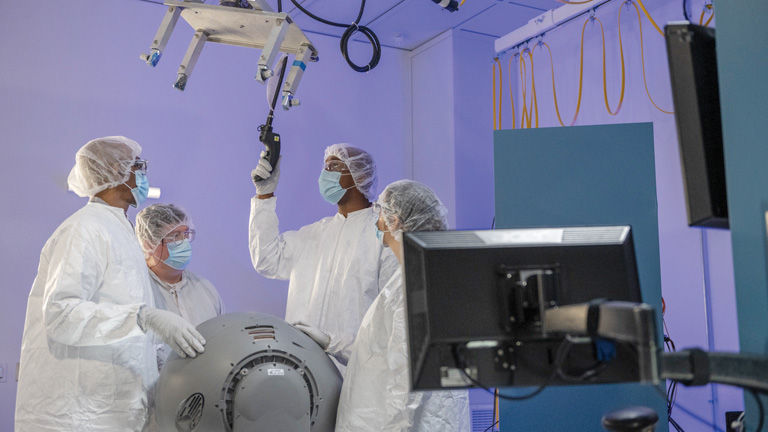
The now ubiquitous terms Industry 4.0 and Smart Manufacturing are effectively synonyms capturing the convergence of technologies that have progressed at an exponential pace over the last several decades. Around 2011, Europe and its industrial base began releasing a strategy for the next industrial revolution, dubbed “Industry 4.0.”
At least five years before that, the spark that would become the flame of Smart Manufacturing was just starting to develop in the U.S. Raytheon Technologies Corp. is harnessing the power of this fourth industrial revolution, in combination with lean manufacturing, to change the way aerospace and defense products are manufactured, delivered, and maintained—including EO/IR sensors to advanced airborne radars. Raytheon has used the power of industrial, manufacturing, and automation engineering analysis to drive selective automation in high-mix, low-volume environments using digital manufacturing simulation, immersive design, design-for-assembly automation, and application of recent advancements in robotics and cyber-physical automation. The smart factory offers the potential to provide products at a combined affordability and level of mission assurance unattainable in previous generations.
One of the key elements allowing the fabric of Smart Manufacturing to be stitched together is the convergence of cyber (digital) and physical automation systems and controls, along with the convergence of traditional IT business systems and OT (operational technology), all augmented by the Internet of Things (IoT), which provides a more universal ability to connect devices and sensors into the manufacturing data fabric. The IoT industry has exploded over that last decade—both commercial and industrial versions of it, with the latter dubbed Industrial Internet of Things (IIoT). This broad technology sub-sector provides a platform for cost savings and efficiency improvements at every level of manufacturing, from design to delivery. Process monitoring, predictive maintenance of high-value assets, management of factory constraints, and asset tracking are clear standouts in the many potential use cases.
Teaming Up on Design
One aspect often overlooked in the integration of automation and Industry 4.0, particularly in the aerospace and defense sector, is design for automation and Industry 4.0. Due to the nature of long development cycles, and often multiple funding sources, the historical waterfall business processes of requirements, design, development, and manufacturing do not lend well to harnessing the power of Industry 4.0—either in digital data collection of key product characteristics used in design and/or sustainment, or physical automation (digital and physical are intertwined in the cyber-physical systems that represent most automation systems today).
The ability to engage in the design at the stage of “concept development” and through the prototyping phases will be a key long-term factor for companies to implement Industry 4.0 successfully. Those phases are typically represented by so-called “technology readiness levels” 3-6 in defense and civil space product development. At Raytheon’s Intelligence & Space unit, we’ve developed a scalable process for early product engagement by manufacturing specialists for assessment and program-phase-appropriate consideration of Industry 4.0 in the product design. This resulted from performing a lot of engagements over several years (“learn by doing”) and refining that process over time.
Often, these engagements take a unique manufacturing concept design skillset from the manufacturing team and knowledge of new manufacturing concepts from the product design teams.
While manufacturing is, by nature, a domain requiring cross-discipline engineering teams, Industry 4.0 provides an exponent to the cross-discipline endeavors by increasing the integration of software and robotics (where physics meets controls) and requires an even tighter integration of design for automation, as well as consideration of digital data and complex architectures that underly those principles. This is true both for the product and the manufacturing systems.
The Human Factor
It is critical for U.S. and allied national strategies to include workforce development and evolution of academic programs to support a cross-discipline endeavor, aligning them with rewarding careers for students. Great examples can be found at the U.S. Clean Energy Smart Manufacturing Innovation Institute (CESMII), Advanced Robotics for Manufacturing (ARM), and the University of Southern California’s Center for Advanced Manufacturing, among other great institutions.
Not only is this new engineering talent pipeline required to support national strategy and competitiveness, our assembly personnel on the factory floor also must adapt to new human-machine interfaces and methods of working—including working hand-in-hand with collaborative robots and having digitally “polka-yoked” (a lean term for error-proofing) workflows, model-based work instructions, and still maintain the mainstream skillsets of assembly and fabrication.
This may seem trivial in words, but anyone who has been stopped from completing a transaction on a web page or computer requiring technical service knows the potential frustration that can come along with digital interfaces and related error-proofing.
In my internal and external presentations on Industry 4.0, I emphasize the importance of keeping the human experience of our factory personnel at the center of the Industry 4.0 technology universe. Those with real Industry 4.0 implementation experience know just how hard that can be. With complex IT/OT technology crossing many technical domains, it’s more akin to developing a user-friendly iPhone GUI than just trying to apply the most sophisticated IIoT technology. I think this is an area where industry is still playing catch up relative to consumer products. This type of human centricity, not just for the factory and business personnel but also for societal benefits writ large, is emerging as the common factor in what may eventually be globally adopted as “Industry 5.0.”
I’ll end with this premise: I am optimistic about the direction of Industry 4.0 and the global realization of societal benefits that future industrial revolutions can bring. And I am proud that Raytheon Technologies helps lead the way in these endeavors, in partnership with national organizations such as SME, CESMII, NSF, our industry partners, and the academic community. I have never felt more certain that the future is here.
Read Again https://news.google.com/__i/rss/rd/articles/CBMiZWh0dHBzOi8vd3d3LnNtZS5vcmcvdGVjaG5vbG9naWVzL2FydGljbGVzLzIwMjIvbm92ZW1iZXIvYWR2YW5jaW5nLW1hbnVmYWN0dXJpbmctYnktYW55LW1lYW5zLW9yLW5hbWUv0gEA?oc=5Bagikan Berita Ini














0 Response to "Advancing Manufacturing by Any Means or Name - sme.org"
Post a Comment